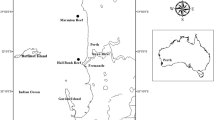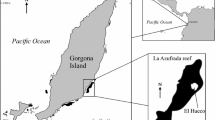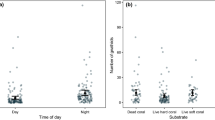Abstract
Population outbreaks of the corallivorous crown-of-thorns seastar (CoTS; Acanthaster spp.) are significant threats to the Indo-Pacific reefs. Although recent research demonstrated that environmental DNA (eDNA) techniques could improve CoTS monitoring, the interpretation of surveillance results has been limited by uncertainties about eDNA dynamics. Here, we conducted aquarium experiments to identify biotic and abiotic factors affecting the shedding and degradation rates of CoTS eDNA. In the first experiment, we investigated the effect of two temperatures (24 and 28 °C) and three feeding treatments (no coral, coral accessible and coral inaccessible) on eDNA shedding rate of laboratory-raised 8-month-old juvenile CoTS. In the second experiment, we quantified CoTS eDNA degradation rate under three temperatures (24, 26 and 28 °C). We found that eDNA shedding rate was affected by feeding treatment (p < 0.0001) but not temperature. Specifically, the shedding rate under coral accessible treatment was about seven times higher than that of coral inaccessible treatment (p < 0.0001), whereas the presence of coral reduced the shedding rate by half (coral inaccessible vs no coral, p = 0.0249). Degradation of CoTS eDNA was rapid (half-life = 14 h) and not affected by temperature. Our results demonstrated that feeding activity increased eDNA release, but some of the released DNA was lost, potentially due to binding to coral surface mucus layer or skeleton. The rapid degradation rate indicated that results of eDNA surveillance likely reflects recent and local occurrence of CoTS. Although further testing is needed, this study provided support for using eDNA as a novel detection tool for early life stages of CoTS on coral reefs.



Similar content being viewed by others
Data availability
The datasets generated during and/or analysed during the current study are available from the corresponding author on reasonable request.
References
Australian Institute of Marine Science AIMS (2017). IMS sea water temperature observing system (AIMS Temperature Logger Program), https://doi.org/10.25845/5b4eb0f9bb848, Accessed 13 Nov 2020
Baird AH, Pratchett MS, Hoey AS, Herdiana Y, Campbell SJ (2013) Acanthaster planci is a major cause of coral mortality in Indonesia. Coral Reefs 32:803–812
Balu V, Messmer V, Logan M, Hayashida-Boyles AL, Uthicke S (2021) Is predation of juvenile crown-of-thorns seastars dependent on age, size, or diet? Coral Reefs 40:641
Barnes MA, Turner CR (2015) The ecology of environmental DNA and implications for conservation genetics. Conserv Genet 17:1–17
Bates D, Mächler M, Bolker B, Walker S (2015) Fitting linear mixed-effects models using lme4. J Stat Softw 67:1–48
Bolker BM, Brooks ME, Clark CJ, Geange SW, Poulsen JR, Stevens MHH, White J-SS (2009) Generalized linear mixed models: a practical guide for ecology and evolution. Trends Ecol Evol 24:127–135
Brauer RW, Barnes DJ, Jordan MJ (1970) Triggering of the stomach eversion reflex of Acanthaster planci by coral extracts. Nature 228:344–346
Brown BE, Bythell JC (2005) Perspectives on mucus secretion in reef corals. Mar Ecol Prog Ser 296:291–309
Burn D, Matthews S, Caballes CF, Chandler JF, Pratchett MS (2020) Biogeographical variation in diurnal behaviour of Acanthaster planci versus Acanthaster cf. solaris. PLoS ONE 15:e0228796–e0228796
Burnham KP, Anderson DR (2002) Model selection and multimodel inference: a practical information-theoretic approach. Springer, New York
Buxton AS, Groombridge JJ, Griffiths RA (2017) Is the detection of aquatic environmental DNA influenced by substrate type? PLoS ONE 12:e0183371
Collins RA, Wangensteen OS, O’Gorman EJ, Mariani S, Sims DW, Genner MJ (2018) Persistence of environmental DNA in marine systems. Commun Biol 1:185
Deaker DJ, Aguera A, Lin HA, Lawson C, Budden C, Dworjanyn SA, Mos B, Byrne M (2020) The hidden army: corallivorous crown-of-thorns seastars can spend years as herbivorous juveniles. Biol Lett 16:20190849
De’ath G, Moran PJ (1998) Factors affecting the behaviour of crown-of-thorns starfish ( Acanthaster planci L.) on the Great Barrier Reef: 1: patterns of activity. J Exp Mar Biol Ecol 220:83–106
De’ath G, Fabricius KE, Sweatman H, Puotinen M (2012) The 27-year decline of coral cover on the Great Barrier Reef and its causes. Proc Natl Acad Sci USA 109:17995–17999
Doyle J, Uthicke S (2020) Sensitive environmental DNA detection via lateral flow assay (dipstick)—A case study on corallivorous crown-of-thorns sea star (Acanthaster cf. solaris) detection. Environ DNA 3:323–342
Doyle JR, McKinnon AD, Uthicke S (2017) Quantifying larvae of the coralivorous seastar Acanthaster cf. solaris on the Great Barrier Reef using qPCR. Mar Biol 164:1–12
Eichmiller JJ, Best SE, Sorensen PW (2016) Effects of temperature and trophic state on degradation of environmental DNA in lake water. Environ Sci Technol 50:1859–1867
Harrison JB, Sunday JM, Rogers SM (2019) Predicting the fate of eDNA in the environment and implications for studying biodiversity. Proc R Soc Lond Ser b Biol Sci 286:20191409
Hartig F (2017) DHARMa: residual diagnostics for hierarchical (multi-level/mixed) regression models. R Package Version 01:5
Hou Y, Wu P, Zhu N (2014) The protective effect of clay minerals against damage to adsorbed DNA induced by cadmium and mercury. Chemosphere (oxford) 95:206–212
Huerlimann R, Cooper MK, Edmunds RC, Villacorta-Rath C, Le Port A, Robson HLA, Strugnell JM, Burrows D, Jerry DR (2020) Enhancing tropical conservation and ecology research with aquatic environmental DNA methods: an introduction for non-environmental DNA specialists: introduction to aquatic eDNA methods. Anim Conserv 23:632–645
Hughes TP, Barnes ML, Bellwood DR, Cinner JE, Cumming GS, Jackson JBC, Kleypas J, van de Leemput IA, Lough JM, Morrison TH, Palumbi SR, van Nes EH, Scheffer M (2017) Coral reefs in the Anthropocene. Nature 546:82–90
Hughes TP, Anderson KD, Connolly SR, Heron SF, Kerry JT, Lough JM, Baird AH, Baum JK, Berumen ML, Bridge TC, Claar DC, Eakin CM, Gilmour JP, Graham NAJ, Harrison H, Hobbs J-PA, Hoey AS, Hoogenboom M, Lowe RJ, McCulloch MT, Pandolfi JM, Pratchett M, Schoepf V, Torda G, Wilson SK (2018) Spatial and temporal patterns of mass bleaching of corals in the Anthropocene. Science 359:80–83
Jo T, Murakami H, Yamamoto S, Masuda R, Minamoto T (2019) Effect of water temperature and fish biomass on environmental DNA shedding, degradation, and size distribution. Ecol Evol 9:1135–1146
Keesing JK, Lucas JS (1992) Field measurement of feeding and movement rates of the crown-of-thorns starfish Acanthaster planci (L.). J Exp Mar Biol Ecol 156:89–104
Kettle BT, Lucas JS (1987) Biometric Relationships Between Organ Indices, Fecundity, Oxygen Consumption and Body Size in Acanthaster Planci (L.) (Echinodermata; Asteroidea). Bull Mar Sci 41:541–551
Klymus KE, Richter CA, Chapman DC, Paukert C (2015) Quantification of eDNA shedding rates from invasive bighead carp Hypophthalmichthys nobilis and silver carp Hypophthalmichthys molitrix. Biol Conserv 183:77–84
Koziol A, Stat M, Simpson T, Jarman S, DiBattista JD, Harvey ES, Marnane M, McDonald J, Bunce M (2019) Environmental DNA metabarcoding studies are critically affected by substrate selection. Mol Ecol Resour 19:366–376
Lacoursiere-Roussel A, Rosabal M, Bernatchez L (2016) Estimating fish abundance and biomass from eDNA concentrations: variability among capture methods and environmental conditions. Mol Ecol Resour 16:1401–1414
Lance R, Klymus K, Richter C, Guan X, Farrington H, Carr M, Thompson N, Chapman D, Baerwaldt K (2017) Experimental observations on the decay of environmental DNA from bighead and silver carps. Manag Biol Invasions 8:343–359
Lenth R (2020) Emmeans: estimated marginal means, aka least-squares means, R package version 1.4.5
Levy-Booth DJ, Campbell RG, Gulden RH, Hart MM, Powell JR, Klironomos JN, Pauls KP, Swanton CJ, Trevors JT, Dunfield KE (2007) Cycling of extracellular DNA in the soil environment. Soil Biol Biochem 39:2977–2991
Ling S, Cowan Z-L, Boada J, Flukes E, Pratchett M (2020) Homing behaviour by destructive crown-of-thorns starfish is triggered by local availability of coral prey. Proc R Soc Lond Ser b Biol Sci 287:20201341
Maruyama A, Nakamura K, Yamanaka H, Kondoh M, Minamoto T (2014) The release rate of environmental DNA from juvenile and adult fish. PLoS ONE 9:e114639
Nakamura M, Okaji K, Higa Y, Yamakawa E, Mitarai S (2014) Spatial and temporal population dynamics of the crown-of-thorns starfish, Acanthaster planci, over a 24-year period along the central west coast of Okinawa Island, Japan. Mar Biol 161:2521–2530
Pratchett MS, Cumming GS (2019) Managing cross-scale dynamics in marine conservation: Pest irruptions and lessons from culling of crown-of-thorns starfish (Acanthaster spp.). Biol Conserv 238:108211
Pratchett M, Caballes C, Wilmes J, Matthews S, Mellin C, Sweatman H, Nadler L, Brodie J, Thompson C, Hoey J, Bos A, Byrne M, Messmer V, Fortunato S, Chen C, Buck A, Babcock R, Uthicke S (2017) Thirty years of research on Crown-of-Thorns Starfish (1986–2016): scientific advances and emerging opportunities. Divers 9:41
R Core Team (2020) R: A language and environment for statistical computing. R Foundation for Statistical Computing, Vienna
Rees HC, Maddison BC, Middleditch DJ, Patmore JR, Gough KC (2014) The detection of aquatic animal species using environmental DNA–a review of eDNA as a survey tool in ecology. J Appl Ecol 51:1450–1459
Robson HLA, Noble TH, Saunders RJ, Robson SKA, Burrows DW, Jerry DR (2016) Fine-tuning for the tropics: application of eDNA technology for invasive fish detection in tropical freshwater ecosystems. Mol Ecol Resour 16:922–932
Saponari L, Montano S, Seveso D, Galli P (2014) The occurrence of an Acanthaster planci outbreak in Ari Atoll, Maldives. Mar Biodivers 45:599–600
Sassoubre LM, Yamahara KM, Gardner LD, Block BA, Boehm AB (2016) Quantification of environmental DNA (eDNA) shedding and decay rates for three marine fish. Environ Sci Technol 50:10456–10464
Schulte PM (2015) The effects of temperature on aerobic metabolism: towards a mechanistic understanding of the responses of ectotherms to a changing environment. J Exp Biol 218:1856–1866
Spear SF, Groves JD, Williams LA, Waits LP (2015) Using environmental DNA methods to improve detectability in a hellbender (Cryptobranchus alleganiensis) monitoring program. Biol Conserv 183:38–45
Stewart KA (2019) Understanding the effects of biotic and abiotic factors on sources of aquatic environmental DNA. Biodivers Conserv 28:983–1001
Strickler KM, Fremier AK, Goldberg CS (2015) Quantifying effects of UV-B, temperature, and pH on eDNA degradation in aquatic microcosms. Biol Conserv 183:85–92
Taberlet P, Coissac E, Hajibabaei M, Rieseberg LH (2012) Environmental DNA. Mol Ecol 21:1789–1793
Takahara T, Minamoto T, Yamanaka H, Doi H, Kawabata Z (2012) Estimation of fish biomass using environmental DNA. PLoS ONE 7:e35868
Thomsen PF, Willerslev E (2015) Environmental DNA: an emerging tool in conservation for monitoring past and present biodiversity. Biol Conserv 183:4–18
Turner CR, Uy KL, Everhart RC (2015) Fish environmental DNA is more concentrated in aquatic sediments than surface water. Biol Conserv 183:93–102
Uthicke S, Doyle J, Duggan S, Yasuda N, McKinnon AD (2015a) Outbreak of coral-eating Crown-of-Thorns creates continuous cloud of larvae over 320 km of the Great Barrier Reef. Sci Rep 5:16885
Uthicke S, Logan M, Liddy M, Francis D, Hardy N, Lamare M (2015b) Climate change as an unexpected co-factor promoting coral eating seastar (Acanthaster planci) outbreaks. Sci Rep 5:8402–8402
Uthicke S, Lamare M, Doyle JR (2018) eDNA detection of corallivorous seastar (Acanthaster cf. solaris) outbreaks on the Great Barrier Reef using digital droplet PCR. Coral Reefs 37:1229–1239
Uthicke S, Fisher EE, Patel F, Diaz-Guijarro B, Doyle JR, Messmer V, Pratchett MS (2019) Spawning time of Acanthaster cf. solaris on the Great Barrier Reef inferred using qPCR quantification of embryos and larvae: do they know it’s Christmas? Mar Biol 23:632–645
Villacorta-Rath C, Adekunle AI, Edmunds RC, Strugnell JM, Schwarzkopf L, Burrows D (2020) Can environmental DNA be used to detect first arrivals of the cane toad, Rhinella marina, into novel locations? Environ DNA 2:635–646
Wilmes J, Matthews S, Schultz D, Messmer V, Hoey A, Pratchett M (2016) Modelling growth of juvenile crown-of-thorns starfish on the Northern Great Barrier Reef. Divers 9:1
Wilmes JC, Hoey AS, Messmer V, Pratchett MS (2019) Incidence and severity of injuries among juvenile crown-of-thorns starfish on Australia’s Great Barrier Reef. Coral Reefs 38:1187–1195
Wilmes JC, Hoey AS, Pratchett MS (2020) Contrasting size and fate of juvenile crown-of-thorns starfish linked to ontogenetic diet shifts. Proc Biol Sci 287:20201052
Wood SA, Biessy L, Latchford JL, Zaiko A, von Ammon U, Audrezet F, Cristescu ME, Pochon X (2020) Release and degradation of environmental DNA and RNA in a marine system. Sci Total Environ 704:135314
Yates MC, Fraser DJ, Derry AM (2019) Meta-analysis supports further refinement of eDNA for monitoring aquatic species-specific abundance in nature. Environ DNA 1:5–13
Acknowledgements
We would like to thank the AIMS SeaSim team for technical support. Funding for this research was provided by the Australian Institute of Marine Science. The contribution of Cecilia Villacorta-Rath was funded through the Australian Commonwealth Government’s National Environmental Science Program – Northern Australia Environmental Resources Hub, Project 4.3.
Author information
Authors and Affiliations
Contributions
All authors jointly conceived and planned the experiment. SK collected the data with methodological support from JD, conducted statistical analysis with support from SU, and interpreted the data with input from SU and CVR. SK wrote the manuscript with feedback from the other authors.
Corresponding author
Ethics declarations
Conflict of interest
The authors declare that they have no conflict of interest.
Ethical approval
Collections were conducted under a permit from the Great Barrier Reef Marine Park Authority (Permit No. G38062.1). Ethical approval under Australian legislation is not required for invertebrates used in this study.
Additional information
Responsible Editor: C. Voolstra.
Publisher's Note
Springer Nature remains neutral with regard to jurisdictional claims in published maps and institutional affiliations.
Reviewers: undisclosed experts.
Supplementary Information
Below is the link to the electronic supplementary material.
Rights and permissions
About this article
Cite this article
Kwong, S.L.T., Villacorta-Rath, C., Doyle, J. et al. Quantifying shedding and degradation rates of environmental DNA (eDNA) from Pacific crown-of-thorns seastar (Acanthaster cf. solaris). Mar Biol 168, 85 (2021). https://doi.org/10.1007/s00227-021-03896-x
Received:
Accepted:
Published:
DOI: https://doi.org/10.1007/s00227-021-03896-x




